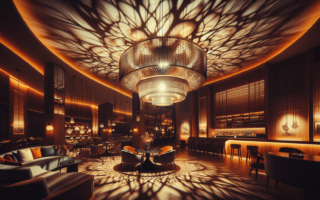Imagine walking into a room and immediately feeling a sense of tranquility and warmth wash over you. The soft glow of the lights accentuates the carefully curated decor, creating an atmosphere that speaks to your soul. In “The Art of Creating Ambience: Mood Lighting Techniques,” we will explore the power of lighting to set the mood and transform any space into a haven of relaxation and beauty. From dimming techniques to strategic placement, this article will guide you through the art of creating an ambiance that perfectly aligns with your desired mood. Get ready to discover the secrets to a truly enchanting environment.

Choosing the Right Lighting
Natural vs. Artificial Lighting
When it comes to creating the perfect atmosphere in a space, lighting is crucial. The first decision you will need to make is whether to use natural or artificial lighting. Natural lighting, such as sunlight, can create a warm and inviting atmosphere, and it can also provide health benefits. Artificial lighting, on the other hand, allows for more control over the intensity and color of the light. It is important to consider the specific needs and characteristics of the space you are lighting to determine which option is best.
Types of Lighting Fixtures
Once you have decided between natural and artificial lighting, it’s time to consider the types of lighting fixtures available. There are various options to choose from, including chandeliers, pendants, track lighting, recessed lighting, and wall sconces. Each type of fixture has its own unique characteristics and benefits. Chandeliers can add elegance and drama to a space, while pendants are perfect for creating focused lighting in specific areas. Recessed lighting is a popular choice for its streamlined appearance, while wall sconces can provide a soft and ambient glow. Consider the style and functionality you desire for your space when selecting lighting fixtures.
Understanding Color Temperature
Another important factor to consider when choosing lighting is color temperature. Color temperature refers to the hue of light, ranging from cool blue tones to warm yellow tones. Cooler color temperatures promote focus and alertness, making them ideal for task-oriented areas like offices or kitchens. On the other hand, warmer color temperatures create a cozy and relaxing ambiance, perfect for living rooms and bedrooms. Understanding color temperature and its impact on mood can help you create the desired atmosphere in your space.
Creating the Ideal Atmosphere
Dimming and Brightening
One of the easiest ways to create the perfect atmosphere is by adjusting the brightness of your lighting. Dimming lights allows you to control the intensity of the light, enabling you to create a cozy and intimate atmosphere. Brightening lights, on the other hand, can help create a vibrant and energetic environment. By installing dimmer switches or using smart lighting systems, you can easily adjust the brightness to suit your mood and activities.
Layering Lights
To create depth and visual interest in a space, it’s important to utilize layering techniques. Layering lights involves combining different types of lighting, such as ambient, task, and accent lighting, to create a multi-dimensional effect. Ambient lighting provides overall illumination, while task lighting is used for specific activities such as reading or working. Accent lighting is used to highlight specific areas or objects, adding a touch of drama to the space. By layering lights, you can create a dynamic and visually appealing atmosphere.
Utilizing Shadows
Shadows are an often overlooked aspect of lighting design, but they can greatly enhance the ambiance of a space. Shadows can add depth and dimension, as well as create a sense of mystery and intrigue. By strategically placing lights and objects, you can manipulate the shadows in your space to create the desired atmosphere. Experiment with different angles and intensities of light to achieve the perfect balance of light and shadow.
Highlighting Focal Points
Using Spotlights
Spotlights are a versatile lighting option that can be used to highlight specific focal points in a room. Whether it’s a piece of artwork, architectural feature, or a prized possession, spotlights can draw attention and create a focal point. Adjustable spotlights allow you to control the direction and intensity of the light, allowing you to create the desired effect. By strategically placing spotlights, you can accentuate the beauty of objects or areas that you want to showcase.
Accent Lighting
Similar to spotlights, accent lighting is used to draw attention to specific objects or areas. Accent lighting can be achieved through the use of wall sconces, track lighting, or even decorative table lamps. By placing accent lights strategically, you can create a focal point or highlight a particular area of interest. Accent lighting adds visual interest and drama to a space, making it an essential technique for creating ambience.
Showcasing Artwork
If you are an art enthusiast, showcasing your artwork is an important consideration when it comes to lighting. Proper lighting can greatly enhance the beauty of artwork, allowing it to take center stage. When lighting artwork, it is important to use directional lighting to eliminate glare and provide even illumination. Track lighting or adjustable spotlights are commonly used for this purpose. Experimenting with different lighting angles can help you achieve the desired effect and ensure that your artwork receives the attention it deserves.
Playing with Color
Color Filters and Gels
If you want to add a splash of color to your space, using color filters and gels can be a fun and creative way to achieve this. Color filters and gels are translucent sheets that can be placed over light sources to change the color of the light emitted. They come in a variety of colors, allowing you to create different moods and atmospheres. Experiment with different colors and intensities to find the perfect combination that suits your space and desired ambiance.
RGB Lights
RGB lights, or red, green, blue lights, offer even more flexibility when it comes to adding color to your space. These lights can be programmed to emit various colors and can often be controlled remotely or through a smartphone app. With RGB lights, you have the ability to create custom lighting scenes and change colors to suit different moods and occasions. Whether you want a calm blue for relaxation or a vibrant red for a party, RGB lights can help you achieve the perfect atmosphere.
Color Psychology
Color psychology is the study of how different colors can affect human emotions and behaviors. When choosing lighting colors for your space, it’s important to consider the psychological impact they may have. For example, blue is often associated with calmness and serenity, making it suitable for bedrooms or relaxation areas. Yellow is often associated with happiness and energy, making it a great choice for kitchens or playrooms. By understanding color psychology, you can make informed decisions about the lighting colors that will best create the desired atmosphere in your space.

Using Light to Alter Perception
Making Small Spaces Feel Larger
If you have a small space that you want to appear larger, lighting can play a crucial role. By using a combination of ambient and accent lighting, you can create the illusion of spaciousness. Ambient lighting provides overall illumination, while accent lighting can be used to highlight specific areas and draw the eye away from the size of the space. By strategically placing lights and using mirrors, you can reflect light and create a sense of depth and openness in your small space.
Creating Depth and Dimension
Lighting can also be used to create depth and dimension in a space. By using a combination of light and shadow, you can add visual interest and make a room feel more dynamic. Experiment with different lighting angles to create interesting patterns and textures on walls or objects. By playing with light and shadow, you can elevate the overall design of your space and create a visually striking atmosphere.
Incorporating Mirrors
Mirrors are a powerful tool when it comes to altering perception with light. By strategically placing mirrors in a space, you can reflect light and create the illusion of more space. Mirrors can also enhance the distribution of light, making a room appear brighter and more open. Consider placing mirrors opposite windows or light sources to maximize the impact. Mirrors not only enhance the ambiance of a space but also serve as stylish decor items.
Controlling Light Direction
Up Lighting
Lighting fixtures that direct light upwards, known as up lighting, can add a sense of drama and elegance to a space. Up lighting can be achieved through floor lamps, wall sconces, or even recessed lighting fixtures. By directing light towards the ceiling or walls, you can create an upward flow of light that adds a soft and diffused glow to the space. Up lighting also helps to create a warm and inviting atmosphere, making it a popular technique for living rooms and dining areas.
Down Lighting
Down lighting refers to light fixtures that direct light downward, illuminating the space below. This technique provides more focused and concentrated lighting, making it ideal for task-oriented areas like kitchens or study areas. Pendant lights, track lights, and recessed lighting are commonly used for down lighting. By installing down lights strategically, you can create functional and efficient lighting that enhances the functionality of the space.
Wall-Washing
Wall-washing is a technique that involves illuminating an entire wall to create a dramatic and visually striking effect. This technique is achieved by using evenly spaced and adjustable light fixtures, such as track lighting or wall-mounted spotlights. Wall-washing not only highlights the architectural features of a space but also provides a soft and diffused light that adds warmth and depth. This technique is often used in galleries or exhibition spaces to create a captivating visual experience.

Designing for Specific Moods
Relaxation and Tranquility
If you want to create a relaxing and tranquil atmosphere in your space, consider using warm color temperatures and soft, diffused lighting. Dimmers can provide the flexibility to adjust the brightness to a comfortable level. Incorporating candles or string lights can also add a cozy and intimate touch. A combination of ambient and accent lighting can help create a serene and calming environment, perfect for unwinding after a long day.
Romantic and Intimate
For a romantic and intimate atmosphere, opt for soft and warm lighting. Use dimmers to create a gentle and flattering glow, complemented by candles or fairy lights. Consider incorporating accent lighting to highlight specific areas or objects, such as a dining table or a cozy seating area. By using warm colors and soft lighting, you can set the mood for a romantic evening or special occasion.
Energizing and Stimulating
When you want to create an energizing and stimulating atmosphere, brighter and cooler lighting is the way to go. Use higher color temperatures and bright white light to create a vibrant and invigorating environment. Utilize task lighting in areas where you need to focus and be productive, such as home offices or kitchens. By incorporating brighter lighting and cooler colors, you can create an atmosphere that promotes energy and productivity.
Utilizing Smart Technology
Wireless Control Systems
Wireless control systems allow you to effortlessly adjust and control your lighting from anywhere in the room. With the help of smartphone apps or remote controls, you can easily dim or brighten lights, change colors, or even create custom lighting scenes. This technology provides convenience and flexibility, allowing you to tailor the lighting to suit your mood or specific activities with just a few taps or clicks.
Timers and Sensors
Timers and sensors are another useful feature of smart lighting technology. Timers can be programmed to turn lights on and off automatically at specific times, ensuring that your space is always illuminated when needed. Sensors, on the other hand, can detect motion or the level of natural light and adjust the lighting accordingly. These features not only provide convenience but also help save energy by ensuring that lights are only on when necessary.
Voice-Activated Lighting
Voice-activated lighting systems have gained popularity in recent years, making it even easier to control your lighting. With virtual assistants like Amazon Alexa or Google Assistant, you can simply use your voice to adjust the brightness, change colors, or turn lights on and off. This hands-free control allows for a seamless and effortless lighting experience, adding a touch of modernity and convenience to your space.

Outdoor Lighting Techniques
Pathway and Walkway Lighting
Outdoor spaces deserve just as much attention when it comes to lighting. Pathway and walkway lighting not only provide safety by illuminating pathways but also enhance the aesthetics of your outdoor area. Low-level lighting options such as bollard lights or solar-powered LED lights can be used to create a soft and inviting glow along the path. Consider incorporating timers or motion sensors to make sure your pathway lighting is energy-efficient and functional.
Entertaining Areas
When designing outdoor entertaining areas, it’s important to create a warm and welcoming atmosphere. String lights or lanterns can add a festive and cozy touch, creating a magical ambiance for gatherings. Additionally, consider installing wall sconces or pendant lights to provide functional and stylish lighting in seating or dining areas. By combining different lighting techniques, you can create an outdoor space that is perfect for hosting parties or enjoying a quiet evening with friends and family.
Water Features and Landscaping
Water features and landscaping can be beautifully enhanced by strategically placed lighting. Underwater LED lights can be used to illuminate fountains or ponds, creating a mesmerizing effect. Up lighting can be used to highlight trees or shrubs, adding depth and drama to the landscape. By incorporating outdoor lighting into your water features and landscaping, you can transform your outdoor space into a captivating and enchanting retreat.
Adjusting Lighting for Different Activities
Reading and Studying
For reading and studying, it’s important to have focused and task-oriented lighting. Position a table lamp or adjustable desk lamp in a way that directs light onto the reading material or work surface. Opt for cool white or daylight color temperatures to promote alertness and concentration. Having adequate lighting in these areas helps reduce eye strain and ensures that you can comfortably engage in reading or studying activities.
Cooking and Dining
The kitchen and dining area often serve as gathering spaces, so it’s important to have versatile and functional lighting. Consider using a combination of ambient, task, and accent lighting to create a well-lit and inviting atmosphere. Overhead lighting or pendant lights can provide general illumination, while under-cabinet lighting or track lighting can be used for task-oriented activities such as food preparation or cooking. Dimmers can also be useful in dining areas, allowing you to adjust the brightness to create a cozy and enjoyable dining experience.
Movie Nights and Entertaining
Creating the perfect ambiance for movie nights and entertaining requires dimmable and atmospheric lighting. Consider using wall sconces or low-level floor lamps to create a soft and subtle glow in your entertainment area. Install dimmers to adjust the brightness according to your preferences and the specific atmosphere you want to create. By incorporating cozy and dimmable lighting, you can set the stage for a memorable movie night or a fun-filled gathering.
In conclusion, the art of creating the perfect ambience through lighting techniques is all about balance, creativity, and understanding the specific needs and characteristics of the space you are lighting. By considering factors such as natural vs. artificial lighting, types of lighting fixtures, color temperature, and the different techniques mentioned above, you can transform any space into a captivating and inviting atmosphere. So go ahead, get creative, and let the magic of lighting elevate your surroundings.



